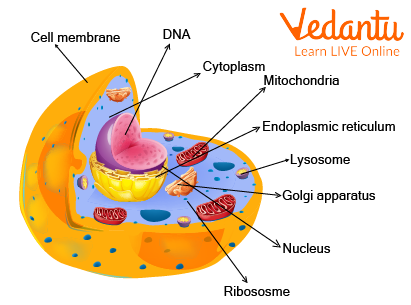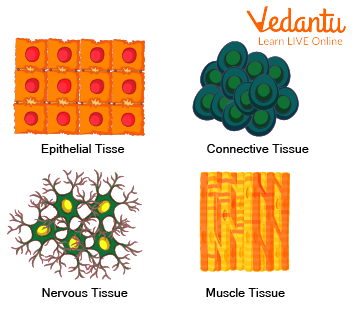




Explanation of Building Blocks of The Body
Living organisms are constructed from biological building blocks. The building block of the body is a cell. A biological building block is the smallest element that contributes to the creation of an organism. If the organism is made up of one cell it is known as unicellular and if the organism is made up of more cells it is known as multicellular.
The cell was discovered by Robert Hooke in 1665. Cells provide structure to our body and perform different functions like healing and repairing wounds. A group of cells join together and form tissue. There are four types of tissue epithelial, muscle, nervous and connective tissue. In this article, we will learn in detail about tissue and cells.
What are Cells?
Cells are a component of life, these are also called structural and functional units of life. Simple bacteria and more complex organisms like people and animals are made from these tiny building blocks. Prokaryotic and eukaryotic cells are among the various types of cells based on complexity:
Prokaryotic: Bacteria and other single-celled, simplest organisms fall under this category. These cells are small with an internal nucleus and compartments.
Eukaryotic: Plant and animal cells are more complicated and are categorised as eukaryotic because they have recognized internal components as well as a real nucleus. One kind of eukaryotic single-celled organism is yeast. Others are typically multicellular.
What are the Main Building Blocks of Tissues and Organs?
Cells are the main building blocks of tissues and organs of the body which are mainly made up of proteins such as:
Tendon and ligament cartilage (collagen and elastin)
The element of muscles that contract (actin and myosin)
nails, hair, and skin (keratin)
Blood proteins (haemoglobin transferrin albumin and globulins)
Enzymes
Hormones
Facts About Cells
The fundamental building blocks of all living things are cells. There are many trillions of cells in the human body, and each one serves a specific purpose.
All living things have cells as their fundamental building blocks.
Cells give the body structure, absorb nutrients from food, and perform critical tasks.
Tissues are made up of a combination of cells that come together to form organs like the heart and brain.
Organelles are a class of useful structures found in our cells.
These organelles perform functions like producing proteins, processing chemicals, and giving the cell energy.
The nucleus, which is located in the centre of the cell, serves as the cell's "control room."
Within the nucleus DNA is present.

Structures of an Animal Cell
Facts About Tissues
A tissue is a component of an organ in both plants and animals. They are a collection of cells that share the same origins, composition, and purpose. Cells assemble into tissues, which the body uses to carry out specific tasks. The cells have an identical appearance, or nearly so. A tissue's cells perform the same or nearly the same tasks.
The four main kinds are:
Connective tissue
Muscles
Nerves
Epithelial tissue
Organs are composed of various types of tissue. An organ is a heart. It is composed of various tissues. Its myocardium is a type of muscle tissue. It has connective tissue on the outside and inside (endocardium) (pericardium). The heart has valves that ensure the blood flows through the heart in the proper direction. Consequently, the heart is an organ made of various tissues.
Types of Tissues in the Human Body
The four fundamental types of tissue are connective, epithelial, muscular, and nervous.
Connective Tissue:- Other tissues are supported by and bound together by connective tissue. Examples- bone, blood, and lymph tissues. It helps in binding organs and provides support.
Epithelial Tissue:- These are formed by cells that cover the external part of the body. An example is skin. It protects internal organs.
Muscle Tissue:- Muscle tissue is involved in movements like pumping blood, and maintaining a posture.
Nervous Tissue:- It is also known as neural tissue. It helps transmit information inside the body.

Four Types of Tissue
Summary
The cell is the smallest unit. It forms all living organisms. Single-celled organisms are known as unicellular organisms and multicellular organisms are made up of more than one cell. Cells provide structure and support to the body. There are two types of cells based on cellular structure prokaryotic and eukaryotic. A group of cells that have similar shapes and functions is known as tissue. They provide protection and support to the body. The four types of tissues are connective, epithelial, nervous, and muscle tissue. Hope this article is beneficial for you.
FAQs on Know About Building Blocks of The Body
1. Write down the Facts About the Body.
The Facts About the Human Body are as follows:
About 300 bones are present at birth, but some of these bones join together as the child grows. Only 206 bones remain by the time they reach adulthood.
The hands, wrists, feet, and ankles contain more than half of your bones.
25 million new cells are created by your body every second. That indicates that you will have produced more cells in 15 seconds than there are Americans.
The femur, or thigh bone, is the biggest bone in the human body. Your eardrum contains the stirrup bone, which is the tiniest bone.
The human body contains 60,000–100,000 miles of blood vessels. They would be long enough to circle the globe more than three times if spread out and laid end to end.
Although not considered to be actual bones, teeth are regarded as a component of the skeletal system.
The brain consumes 20% of our blood and oxygen intake despite making up only 2% of our total body mass.
Your body has a water content of roughly 60%.
2. What are the three building blocks of the body and what is the building block of DNA?
The components amino acids, lipids, and nucleotides are three that are crucial. Our cells use each to create the more intricate molecules and structures required for life. However, the processes used to create each of these in contemporary biology are very different from those used during the origin of life.
The fundamental component of nucleic acids is called a nucleotide (RNA and DNA). The components of a nucleotide are a sugar molecule (either ribose in RNA or deoxyribose in DNA), a phosphate group, and a base that contains nitrogen. Adenine (A), cytosine (C), guanine (G), and thymine are the bases that are used in DNA (T).
3. Where are cells found in the body?
Cells in the human body number in the trillions and come in all shapes and sizes. These tiny structures are the basic unit of living organisms. Cells comprise tissues, tissues make up organs, organs form organ systems, and organ systems work together to create an organism and keep it alive.









